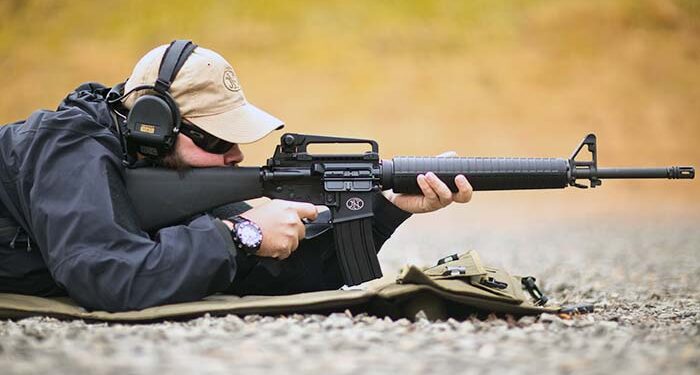By Christopher R. Bartocci
The Global War on Terrorism has shown some very interesting trends in small arms for the United States. The full size M16-series rifle has for the most part taken a back seat to the lighter and more compact M4 carbine. There is no doubt that the shorter carbine is easier to maneuver in and out of vehicles and is better for close quarter battle. There is always an exception to the rule and that is the Marine Corps. They have chosen to keep the full size battle rifle and have limited use of the M4 carbine. By tradition the Corps has always been prideful of their marksmanship skills and the 20” barrel provides additional range where their skills can truly shine.

The M16A4 (NSN 1005-01-383-2872) was a direct descendent of the advancements of the M4 carbine. The Marines were the driving force for the M16A2. To go along with their tradition of marksmanship the complex rear sight, adjustable for windage and elevation, was developed. Oddly enough, this sight was quite expensive and the Marines were the only branch that ever trained on its use and shot far enough to make it beneficial. The Army shot basically to 400 yards and that was it while the Marines shoot out to 600 yards. The Marines were also responsible for the infamous 3-round burst mechanism which would haunt the American serviceman until the more recent M4 Product Improvement Program where the burst was finally removed and the automatic setting restored. The burst mechanism has truly been mind boggling. The M16 was developed during the war in Vietnam to significantly increase the firepower on the individual level and to match the firepower of the intermediate caliber AK47. It did just that. Then the M16A2 comes along and now the firepower on the individual level was reduced. The US government was the only customer Colt had ever order a rifle with a BURST setting. Export rifles were most always shipped with the automatic configuration.
In the interim was the ACR or Advanced Combat Rifle program where the US government was looking for a potential replacement for the M16A2 rifle. The most significant goal was to increase hit probability. The Colt entry would use a flat top upper receiver which you could use iron sights provided on a removable carrying handle or mount an optic directly to the receiver and have the optic in line with the shooter’s eye. Mounting an optic on a fixed carrying handle was quite uncomfortable due to how heigh the optic sat on the carrying handle. However this dovetail had some inherit flaws. First the slots in the dovetail were extremely thin. In fact, Richard Swan stuck a pencil through the slot into the inside of the receiver! Second was the stop notches were rounded at the bottom. These issues were not corrected on the ACR but would be addressed on the Mil-Std-1913 rail.
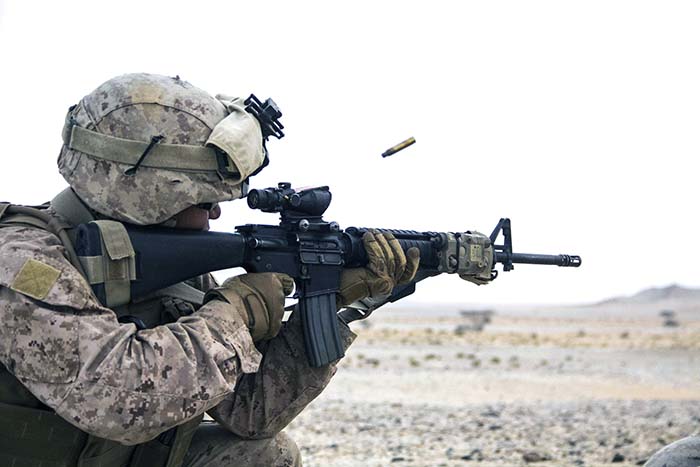
The flat top upper receiver of the M4 with the Mil-Std-1913 rail was truly a game changer and offered an epic degree of adaptability to the M4. Prior to 9/11, almost all rifles in the US arsenal were fixed sight battle rifles. The Canadian Army was the first to pioneer the standardized flat top upper receiver for general military use. They developed their own “Weaver Rail dovetail” for mounting optics. The Canadians moved forward with their ELCAN optics and became the first nation in the world to give every soldier a magnified optic. This also took advantage of the inherent accuracy of the M16 weapons platform. The new family of Canadian weapons created were the C7A1 and the C8A1 family of rifles. US military developments were to follow. It was found that the Weaver rails, although good were not uniform. What was needed was a standardized dovetail which would be accurate and durable. The same man who assisted the Canadians with their flat top rail would go on to help the American government. Mr. Richard Swan of ARMS, Inc is the father of the Mil-Std-1913 rail. When broken down, the Mil-Std-1913 rail has basically three inventors. First is the actual upper receiver with a dovetail, this was designed by Henry Tatro at Colt in the 1970’s. The dovetail itself was designed by Weaver. The final standardized dovetail was done by Richard Swan. Oddly enough the rail is referred to by many as the “Picatinny Rail” named after the Picatinny Arsenal. Picatinny Arsenal had nothing to do with the design of the rail, they were just the project manager. The XM4 would be developed with a standard M16A2 fixed carrying handle with the fully adjustable rear sight for windage and elevation but the final M4 would use the new Mil-Std-1913 flat top upper receiver.
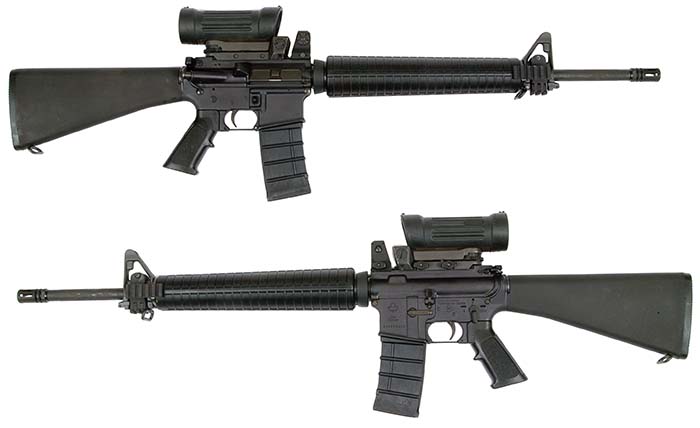
Colt would go on to adapt the M16A2 to the flat top configuration. The prototype was the M16A2E4 which would be type-classified the M16A4. Government drawing number 12973001 and Colt model number R0945. The stop notches on the rail would be changed to a much more durable and reliable square configuration. Unlike all previous designs by anybody, the rail now had final standardized dimensions. Now mounts could be uniformly made to mate with the dovetail. We now have the Mil-Std-1913 rail. The rifles were provided with a detachable carrying handle with the fully adjustable A2 sights. Due to the available dimensions, the rear sight could only be calibrated to 600 meters instead of 800 meters.
The M16A4 as of July 29, 1997 has officially replaced the M16A2 as the standard issue combat rifle for the United States Army and Marine Corps. They will no longer procure any M16A2 (fixed carrying handle) rifles. Colt’s Manufacturing Company, Inc was awarded a contract (DAAE20-98-C-0119) for $6,371,568 to supply the U.S. Government with just over 32,000 M16A4 rifles and was completed and the M16A4 rifles were delivered in the spring of 2001. Colt has manufactured numerous M16A4 rifles for the United States Government but the vast majority of M16A4 rifles have been manufactured by FNMI.

Initial rifles were produced with standard A2-style handguards and removable carrying handles. The rifle retained the BURST setting of the M16A2. With the exception of the upper receiver and detachable carrying handle all other components of the M16A4 remained compatible with the M16A2. With the adoption of the SOPMOD accessories for the M4, the M16A4 would follow. The round handguards would be replaced with the Knight’s Armament M5 Rail Adapter System. This enabled the M16A4 to do several things. It provided quad Mil-Std-1913 rails. This permitted the attachment of flashlights, lasers, vertical pistol grip as well as night vision to name a few. The infrared laser would become very effective with the use of night vision. The bottom rail could be removed enabling the attachment of an M203 grenade launcher. New grenade launcher sights were designed to attach to the left or right rail to enable the use of optics on the rifle. The detachable carrying handle would go on to be replaced by the Matech back up iron sight which was small and compact. The sight is adjustable for windage and elevation. If the optic was to fail, the rear sight could be engaged and the soldier could shoot with iron sights. Depending on the optic, it may co-witness with the iron sights or it may need to be removed.

Literally there are hundreds of optics that can be mounted on the rifle. The most common is the Trijicon ACOG (Advanced Combat Optical Gunsight) TA31RCO – A4 (NSN: 1240 – 01 – 525 -1648). The A4 on the end indicates bullet drop compensator calibrated for the 20 inch barrel. This is standard issue on the US Marines M16A4 rifles. This is a 4x32mm optic which is powered both by a tritium lamp as well as a fiber optic on top of the scope. Batteries are not required increasing the desirability of this optic. The tritium lamp illuminates the reticle in total darkness while the fiber optic self-adjusts light intensity during daylight according to ambient light conditions. This also allows the shooter to keep both eyes open while engaging targets and maintaining maximum situational awareness. There is a bullet drop compensator built in for the 62gr M855 round. The body of the optic is manufactured from a 7075 T6 aluminum forging, the same as the rifle receivers. The ACOG is attached by a thumbscrew adapter to mount to the Mil-Std-1913 rail. Also available is a killFLASH® Anti-Reflection Devise. This covers the front of the optic to eliminate lens reflection which could reveal one’s location. The ACOG was first used by SOCOM in the SOPMOD Block I Accessory kit. Here the sight gained an excellent reputation for durability and reliability. This optic has been updated and improved over the years resulting in the TA31RCO-A4 and TA31RCO-M4 optics being procured today.
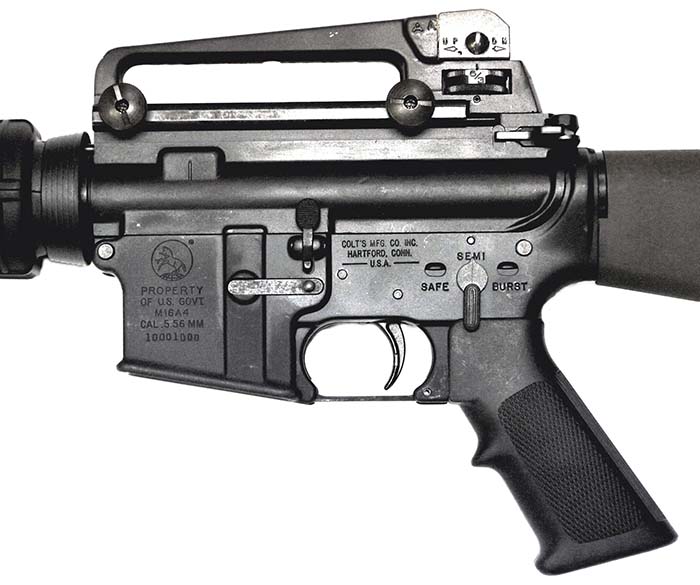
Other popular optics are the M68 Comp2 reflex sight designed by Aimpoint. After 18 months of grueling testing, the Army in 1997 awarded Aimpoint the world’s first military contract for a red dot sight. The current issue is the CompM4 which uses a single AA battery. Aimpoint claims 8 years continuous use from a single AA battery. The intensity of the dot is controlled by a rotary switch on the rear of the optic. There are two models. The early Comp4 has the activation switch and battery compartment on the top right of the optic. The Comp4S (M68CCO) has relocated the switch/battery compartment to the lower right of the optic. The Comp4/4S are night vision (3rd generation) compatible. There are 7 night vision compatible and 9 standard settings of brightness of the dot. The dot is 2-MOA in size. With the standard mounting system, the optic is co-witness with the iron sights. In other words, if the optic was to fail, you may engage your back up sights and you will be able to see the sights through the lens of the optic. To add to the versatility of the Comp4 series, Aimpoint makes a 3x magnifier which mounts behind the sight. The mount allows for pivoting of the magnifier. If you are in a CQB environment you have the 3x magnifier disengaged. Once you need extended range you engage the magnifier and you have a longer range optic.
Another popular accessory is the Specter Gear CST 3-point tactical sling. The sling is 1.25 inches wide and fully ambidextrous. It can be got with a Emergency Release Buckle. This sling does quite a few unique things. The transitional release buckle allows the sling to be quickly extended to allow slack so the rifle can be transitioned from one side to the other. The rifle can be made to hang out of the way from any position of the body and drawn up quickly when needed. Models are also made for the rifle with the M203 as well as the M4 carbine. Another accessory often added is a magazine pouch that sits on the side of the stock. It holds one 30 round magazine. It can be mounted either to the right or the left side, whichever way the sling is installed on the rifle.
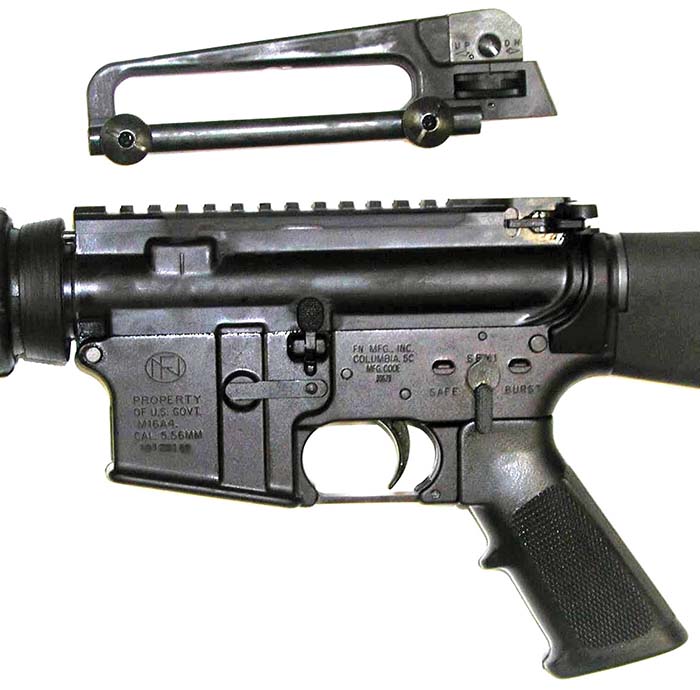
In late 2002, after testing, the United States Marine Corps passed over the M4 and M4A1 carbine for the M16A4. According to the Marine Corps this decision was based on reliability. The last week of October, 2002 FNMI received a contract from the Marines for 4,264 M16A4 rifles with a later contract for an additional 27,000 rifles. All Marine Corps M16A4 are equipped with the M5 Rail Adapter System (RAS) for installation of SOPMOD Kit components such as ACOG Reflex Sight as well as the ACOG Day Optical Sight.
As of this writing, both the Army and Marines have procured the M16A4. However, the Army has procured on a very limited basis in favor of the M4 carbine. The Marines continue to procure the M16A4 as its main rifle. This goes back quite some time. During the Army’s XM8 program, the Marines said they would not procure XM8 rifles in favor of the M16A4. They are very pleased with it.
Commercial Versions of the M16A4
Like all military rifles or military equipment for that matter there are always commercial demands. In this case, many companies make a M16A4 rifle in semi-automatic only configuration. But everybody wants the real deal, from the manufacturers who make the rifles for the government. Now they have it with the Colt AR-15A4 and the FN15.
Colt Defense has always been primarily a defense contractor manufacturing weapons for military use. In the 1992-1994 time period, Colt put out its first flat top rifle, the Sporter Competition HBAR Range Selected (R6700CH) which was a 20 inch heavy barrel with no bayonet lug. This was just before the Assault Weapon Ban of 1994. Since then, there were post ban match target series rifle but none of them were of the exact specification of the M16A4. With the sunset of the ban, Colt kept in place the post ban configurations of their commercial rifles due to the fact there were several states which still had bans in effect. Also Colt was doing little in the commercial market due to wartime production of the M4. The Law Enforcement weapons were all of the carbine variations. Colt was producing very little in the area of standard rifles.
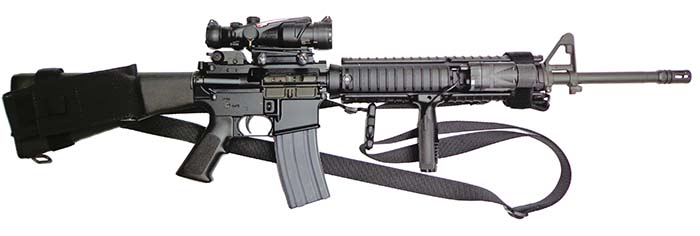
In January of 2014 the first commercial M16A4 rifles left Colt, these rifles are called the AR-15A4. This is significant in two ways. First, Colt started using the AR-15 designation on commercial rifles since the late 1980’s. Secondly, they introduced their M16A4 to the commercial market. The decision was greatly based on customer requests. Many Colt customers had returned from Iraq and Afghanistan having used rifles in both the A2 and A4 configuration. So Colt felt it would be important to go back and make an up-to-date commercial rifle configuration that featured a government profile barrel as well as flat top upper receiver.
The Colt AR-15A4 for all intents and purposes is an M16A4 with a semi-automatic only trigger group (semi-auto only lower). It comes with the standard round handguards and detachable carrying handle. Why bare bones? Simply you cannot make everyone happy. Everybody likes their own flavor of stock, rail system, back-up sight, trigger and optic. It is wiser for Colt to provide the basic model and save the customer the money from purchasing additional equipment that the customer will change out anyway. Colt does offer some enhancements over the standard design. The AR-15A4 comes with extended feed ramps. Although not necessary for reliability, it assists in feeding certain types of projectiles without damaging them. Also the rifle comes with an ambidextrous safety and a PMag instead of the aluminum GI magazine. The PMag is a great enhancement in durability and reliability over the aluminum magazine. Also models are offered with Magpul MOE fixed stock, pistol grip, rear sight and handguards in flat dark earth colors. There will be others limited editions offered in various colors. Hopefully one will include a GI model with an M5 RAS and Matech BUIS!
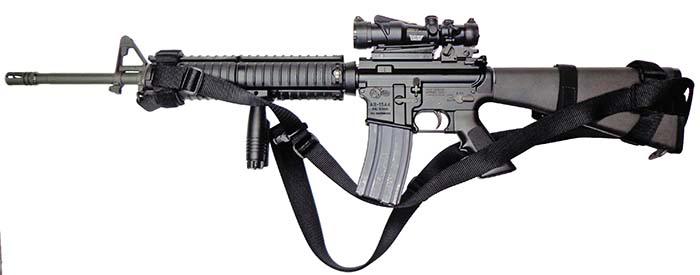
The FN15 Rifle
As previously stated the vast majority of M16A4 rifles were produced by FNMI. Up until January of 2014, FN has never manufactured a semi-auto only rifle of this family of weapons. This leads up to many complicated issues. The TDP does not allow FNMI to use it for any purpose other than making government guns. The FNMI commercial rifles are not made with the government data enabling FNMI to enter the commercial market with the FN15. They offer both a 20 inch barrel rifle and a 16 inch carbine. The FN15 rifles are built in Colombia, SC but on different production lines than their US Government M16A4 rifles and M4 carbines. Recently FNMI was awarded the contract to produce M4 carbines from the US government. Colt Defense had produced as a sole source for the US Government up until this time. After the sole source contract was completed the government put the M4 out for competitive bidding. First the contract was won by Remington. Colt Defense challenged the contract for price issues, it was found the price Remington quoted did not include the royalty Colt gets and the competition was opened up again. When the bidding was done, FNMI took the contract from both
Remington and Colt.
The FN15 rifles marking differ from the military rifle. For instance the FN logo is laser etched on the right side of the magazine well. The barrel has proof marks but uses they stylized FN logo instead of the military marking. The barrel has button cut rifling with a 1 turn in 7 inch twist and is chrome plated bore and chamber. The barrel extension has M4-style feed ramps cut. Significant attention was made to make the rifle look as close as possible to the government rifle. The rifle is marked manufactured by FNH USA out of Fredericksburg, VA.
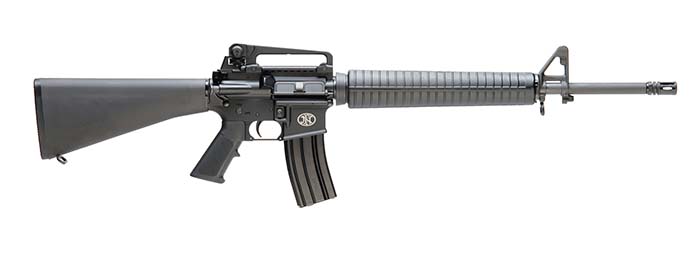
Like the Colt, the FN15 is bare bones allowing for the customer to customize as per their taste. The rifle comes with the removable carrying handle as well as round handguards. The quality is what one would come to expect from FNMI.
The commercial market demands the same as the military gear. Now one can procure commercial versions of both the M16A4 and M4 carbine by the two most prolific manufacturers for the U.S. government, Colt and FN. All the returning veterans wish to procure the closest to the same weapon they carried in Iraq and Afghanistan from the manufacturers they trusted with their life. The AR15-series rifle is truly the “grown mans erector set”. You take a bare bones rifle and build what your individual flavor is. The M16A4 rifle is not going anywhere, you can expect to see it in all of the US areas of conflict for many years to come. Now Colt and FN are allowing that historical weapon in the commercial market for those who will appreciate the significance of it.
| This article first appeared in Small Arms Review V20N8 (October 2016) |



